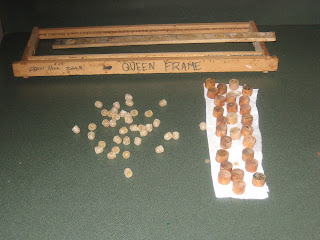


Last year a buddy and I plugged oak logs with shiitake mushroom spawn. They were so delicious that I decided to do it again myself this year. The process is simple. You take branches or small trees that were felled in winter (Jan/Feb is ideal) and cut them into 3-4' lengths. The logs should be no more than 6-7" in diameter ideally. The following April you drill holes in the logs that are the same depth as the dowel plugs are long. You gently tap the plugs into the holes and seal them over with cheese wax to prevent the spawn-laden dowel from drying out. Then you wait. The logs are 'racked' for a year to allow time for the mycelium to colonize the sapwood to the point that it's ready to bear fruit. The spring rains stimulate the logs to produce mushrooms. You can 'fool' the logs into fruiting by soaking them in cold water. I use a stock tank and soak about 4 logs at a time.







